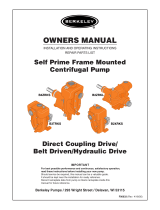
INSTRUCCIONES SOBRE SEGURIDAD
Especificaciones
16
Riesgo de muerte, lesiones personales o daños materiales por
explosión, incendio o descarga eléctrica.
• No usar para bombear líquidos inflamables o explosivos como gasolina, fueloil, kerosene, etc.
• No usar en atmósferas explosivas ni lugares peligrosos según la clasificación de la NEC, ANSI/NFPA70.
• No manipule la bomba ni el motor de la bomba con las manos mojadas o parado sobre una superficie mojada o húmeda o en
agua.
• Cuando haya una bomba en su aplicación, no toque el motor, las tuberías ni el agua sino hasta haber desenchufado o eléctrica-
mente desconectado la unidad.
• Si la desconexión de alimentación está fuera del sitio, bloquéela en la posición abierta y etiquétela para evitar una conexión ine-
sperada de la alimentación.
• Si no se tuviera acceso al panel de desconexión, comuníquese con la compañía eléctrica para interrumpir el servicio.
Riesgo de lesiones graves o muerte por descarga eléctrica.
• Para reducir el riesgo de descarga eléctrica, desconecte la energía antes de trabajar en el sistema o cerca de él. Es posible que sea
necesario más de un interruptor de desconexión para cortar la energía del equipo antes de realizarle un mantenimiento.
• Cablee el sistema de bombeo para los voltajes correctos.
• Asegúrese de que esta bomba esté conectada a un circuito equipado con un dispositivo interruptor de circuito por falla de conex-
ión a tierra (GFIC) si es requerido por el código.
• La bomba incluye un conductor a tierra. Para reducir el riesgo de una descarga eléctrica, asegúrese de que esté correctamente
conectada a tierra.
• Para evitar peligros durante la instalación o el mantenimiento, instale un interruptor de desconexión de doble polo cerca de la
instalación de la bomba.
• Utilice una resistencia de descarga adecuada para descargar el condensador antes de trabajar en el motor.
• Compruebe los códigos eléctricos y de construcción locales antes de la instalación. La instalación debe estar de acuerdo con sus
regulaciones, así como el National Electrical Code (NEC) más reciente y la ley de Seguridad y Salud Ocupacionales (OSHA).
Riesgo de lesiones corporales, descargas eléctricas o daños al
equipo.
• Este equipo no deben usarlo niños ni personas con capacidades físicas, sensoriales o mentales reducidas, ni aquellos que carez-
can de experiencia y capacitación, salvo que estén bajo supervisión o instrucción. Los niños no podrán usar el equipo ni jugar con
la unidad o en las cercanías inmediatas.
• No haga funcionar vacía la bomba. Si la hace funcionar vacía, la temperatura de la superficie de la bomba aumentará al punto
que podría provocar quemaduras si se la toca y le causará serios daños a su bomba.
• El equipo puede encenderse en forma automática. Realice los procedimientos de bloqueo/etiquetado antes de efectuar el man-
tenimiento del equipo.
• La bomba únicamente ha sido evaluada para su uso con agua. La bomba solo se debe utilizar con líquidos compatibles con los
materiales que componen la bomba.
• Una bomba que no funciona o funciona mal podría provocar una inundación y provocar lesiones personales o daños materiales.
• La bomba puede calentarse durante la operación. Deje que la bomba se enfríe antes de darle mantenimiento.
• La operación de este equipo exige instrucciones detalladas para su instalación y operación que se encuentran en este manual
para su uso con este producto. Lea la totalidad del manual antes de comenzar la instalación y la operación.El usuario final debe
recibir y conservar el manual para usos futuros.
• Mantenga las etiquetas de seguridad limpias y en buenas condiciones.
• Mantenga el área de trabajo limpia, bien iluminada y ordenada.
• Use gafas de seguridad mientras realiza la instalación o el mantenimiento de la bomba.





















